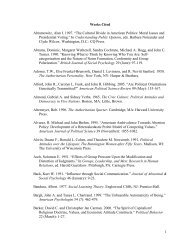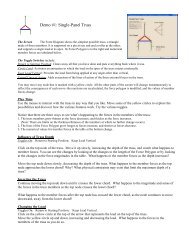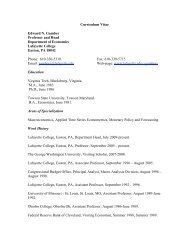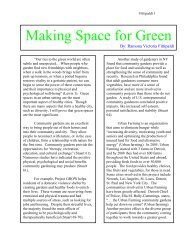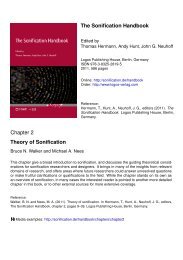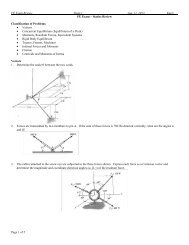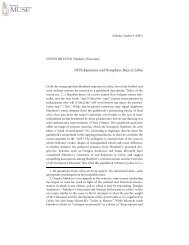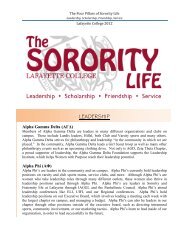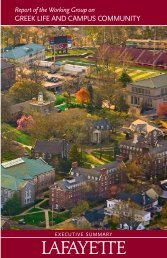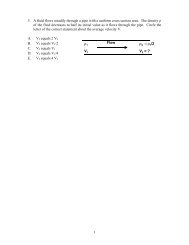2010 - Sites at Lafayette - Lafayette College
2010 - Sites at Lafayette - Lafayette College
2010 - Sites at Lafayette - Lafayette College
Create successful ePaper yourself
Turn your PDF publications into a flip-book with our unique Google optimized e-Paper software.
KeepingCaliforniaRunningCrystal Taylor ’03 plays a keyrole in determining the country’slargest st<strong>at</strong>e budgetThough she’s never playedan action hero in films—unlike thegovernor she answers to— Crystal Taylor’03 faces her own heroic task: finding thenearly $120 billion needed to keep thest<strong>at</strong>e of California running.“It’s a lot of pressure,” she says with achuckle, “but I thrive under pressure.”As budget officer in the executivebranch of the st<strong>at</strong>e’s Franchise TaxBoard, Taylor leads a team of 13 as theycoordin<strong>at</strong>e the budget for the departmentth<strong>at</strong> oversees millions of taxforms and monies th<strong>at</strong> pourin from individuals and businesses.Sifting through thismountain of inform<strong>at</strong>ion tomake the fiscal recommend<strong>at</strong>ionsto the legisl<strong>at</strong>ure behindthe country’s largest st<strong>at</strong>ebudget domin<strong>at</strong>es Taylor’s dayfrom the moment she wakes.“I’m checking email on myBlackberry while I’m brushingmy teeth,” she says.Taylor’s never been one toflinch when confronted witha challenge. She majored inm<strong>at</strong>hem<strong>at</strong>ics <strong>at</strong> <strong>Lafayette</strong>, adiscipline largely devoid ofAfrican American women. Afterhearing a speaker joke aboutthe arduous gradu<strong>at</strong>e economics track <strong>at</strong> Princeton University,Taylor took th<strong>at</strong> challenge toanother level by earning simultaneous master’s degrees(economics & public policy and urban & regional planning,both in 2006).“I want to be th<strong>at</strong> person everyone teases because I’mdoing the hardest work,” she says. Th<strong>at</strong> drive landed herin California’s Legisl<strong>at</strong>ive Analyst’s Office as a fiscal policyanalyst. “I asked the question, Where’s the hardest place where Ican make a difference? I’m going there.”Only two months into th<strong>at</strong> job, Taylor testified beforethe st<strong>at</strong>e legisl<strong>at</strong>ure in a televised hearing, discussingher department’s program ideas, including how to keeptensions low among callers to the st<strong>at</strong>e’s tax call center.When an assemblyman challenged her findings, Taylorbacked her testimony with her call-monitoring fieldwork.“I asked thequestion, Where’sthe hardest placewhere I can makea difference? I’m{going there.”“Speaking truth to power” in th<strong>at</strong>hearing changed Taylor: “I had to findconviction for every word I said.”Today, Taylor’s role makes a differencenot only to the st<strong>at</strong>e’s oper<strong>at</strong>ion, but alsoto the lives of its employees. Confrontedwith a mand<strong>at</strong>e to lay off st<strong>at</strong>e workers,Taylor and her group negoti<strong>at</strong>ed adeal with the governor’s fiscal officersth<strong>at</strong> sub stituted budget alloc<strong>at</strong>ions forunfilled positions with those of workersfacing layoffs, saving 300 jobs.“Even if they don’t know me,” shesays, “I know the decisions I make impactpeople.”Taylor cites more than 20 professors<strong>at</strong> <strong>Lafayette</strong> who altered the course of herown life and gave her the tools to meetCalifornia’s fiscal challenges. Discussingeconomics over dinner <strong>at</strong> the home ofprofessors Gladstone Hutchinson andUte Schumacher built a found<strong>at</strong>ion forTaylor to ask the kind of probing questionsher job demands.“Th<strong>at</strong> someone is willing to takethe time to get to know you and theirbelief th<strong>at</strong> you are special and havepromise, th<strong>at</strong> was inspiring to me, evenwhen I wasn’t so sure th<strong>at</strong> I did,” shesays. “To have someone say ‘you can doit, I believe in you, and here are two orthree steps you can take, a book youcan read to explain the process,’ or evenrecommending a professor to ch<strong>at</strong> withabout your ideas—th<strong>at</strong> was so common<strong>at</strong> <strong>Lafayette</strong> th<strong>at</strong> I can’t imagine being who I am todaywithout it.”Th<strong>at</strong> support helped Taylor as she undertook a seniorthesis proposing a m<strong>at</strong>hem<strong>at</strong>ical model to describe the economicrel<strong>at</strong>ionship between <strong>Lafayette</strong> and the City of Eastonand outlining recommend<strong>at</strong>ions on how these influencescould be more equitable.Helping to manage the behemoth th<strong>at</strong> is California’s taxsystem and her department’s $600 million budget <strong>at</strong> a timeof uncertainty calls on all of Taylor’s multiple skills. Yet oneunexplored skill excites her most of all. This April will bringmore than just a deluge of tax forms to Taylor’s Sacramentooffice—she and husband Edward Torres are expecting theirown little pink-bowed tax deduction. nBy Dan Edelenwww.lafayette.edu/mcdonoghreport Winter <strong>2010</strong> | theMcDonoghreport | 5
AdvancingLeadership andSocial JusticeM<strong>at</strong>h professor Chawne Kimberhelps incoming students and fostersservice learning“The college recognizes its responsibility to help ourn<strong>at</strong>ion produce highly qualified new scientists and engineers,”says Chawne Kimber, associ<strong>at</strong>e professor of m<strong>at</strong>hem<strong>at</strong>ics.“This program aids in getting more students into the pipelinewhile being mindful of the need for diversity in thispopul<strong>at</strong>ion.”Kimber is talking about the Summer Program to AdvanceLeadership, which debuted last year under her direction.During six weeks on campus in July and August, eight incomingstudents in the Class of 2013 earned credit for requiredcourses in college writing and calculus. They also experiencedmodules, present<strong>at</strong>ions, and field trips introducing them totopics and careers in science, technology, engineering, andm<strong>at</strong>hem<strong>at</strong>ics.The students, who come from Brooklyn, Houston, andPuerto Rico in addition to Pennsylvania and New Jersey, wereselected for their demonstr<strong>at</strong>ed academic promise in scienceor engineering and potential to become leaders in those fields.Priority in choosing the participants was given to studentswith high m<strong>at</strong>h SAT scores who come from groups th<strong>at</strong> are oftenunderrepresented in science and engineering <strong>at</strong> <strong>Lafayette</strong>.They received full tuition, books, housing, meals, and astipend to cover wages they could have earned had they beenworking during the six weeks. The program was made possibleby the support of Dan and Heidi Ludwick Hanson ’91.“This has really made me excited for college,” a participantwrote in her evalu<strong>at</strong>ion of the program. “The combin<strong>at</strong>ion ofthe gre<strong>at</strong> people I’ve met here mixed with the wide varietyof knowledge th<strong>at</strong> has been presented to me has contributedto this.”Another wrote, “I became oriented with the professors, campus,and college life while I was not under the stress of meetingall the new students and a full course load in the fall.”Helping students prepare for success is a passion forKimber, who was honored with the <strong>College</strong>’s MarquisDistinguished Teaching Award last May.“I want to know each and every one of my students. I wantto give them the best educ<strong>at</strong>ional experience possible,” shesays. “For me, my office hours are where the real learninghappens. I absolutely love it when my students come to visitme, because it means th<strong>at</strong> they are dedic<strong>at</strong>ed to learning andinterested in being better <strong>at</strong> wh<strong>at</strong> we’re working on.”As her role in the summer program suggests, anotherpassion of Kimber’s is social justice concerns. With acolleague <strong>at</strong> Middlebury <strong>College</strong>, she was awarded a Learnand Serve America grant from the Corpor<strong>at</strong>ion for N<strong>at</strong>ionaland Community Service to organize a course-developmentworkshop on the m<strong>at</strong>hem<strong>at</strong>ics of social justice two summersago. She also led the effort to land another grant th<strong>at</strong> helpedfund the launch of <strong>Lafayette</strong>’s Community Based Learningand Research Initi<strong>at</strong>ive.The aim of the m<strong>at</strong>h workshop was to broaden the baseof college m<strong>at</strong>h faculty serving as voices of experience in incorpor<strong>at</strong>ingsocial justice questions into their teaching andto expand course-development resources for m<strong>at</strong>h faculty,including service-learning and other project models. Theevent built on a prior workshop hosted <strong>at</strong> <strong>Lafayette</strong> by RobRoot, professor of m<strong>at</strong>hem<strong>at</strong>ics.Two dozen faculty members from various colleges anduniversities worked in small groups to produce modules foruse in m<strong>at</strong>h and st<strong>at</strong>istics courses to help students connectquestions of equity to quantit<strong>at</strong>ive analysis and deductivereasoning, and to extend their analytical and reasoningabilities in the process.“Of course, wh<strong>at</strong> we do regularly in teaching college-levelm<strong>at</strong>hem<strong>at</strong>ics courses is to provide quantit<strong>at</strong>ive literacy,albeit on a very high level,” says Kimber. “Wh<strong>at</strong> this projectdoes is to <strong>at</strong>tempt to teach students how they may use theirquantit<strong>at</strong>ive literacy for the good and why basic innumeracyin our citizens is often the result of some social injustice.”The Community Based Learning and Research Initi<strong>at</strong>iveprovides the infrastructure to support academic servicelearningand community-based research <strong>at</strong> the <strong>College</strong>. Itenhances the efforts of faculty across all disciplines whoseteaching and research benefit the community. nRyan Yarde ’13 and Andrea Mikol ’13 w<strong>at</strong>ch theirstructure fall during an earthquake demonstr<strong>at</strong>ion in theSummer Program to Advance Leadership.<strong>Lafayette</strong> UndergoingCampus Clim<strong>at</strong>e Study“As we begin the new academic year, I wanted to take amoment to share with you our commitment to cre<strong>at</strong>ingand maintaining an inclusive community th<strong>at</strong> values,affirms, and advances the diverse backgrounds, interests,experiences, and aspir<strong>at</strong>ions of all its members,”said President Dan Weiss in a message to the campus<strong>at</strong> the start of the school year. “We believe th<strong>at</strong> acritical step in cre<strong>at</strong>ing an inclusive environment is toassess the current campus clim<strong>at</strong>e in order to identifyimportant issues, and then cre<strong>at</strong>e ways for individuals,departments, and the administr<strong>at</strong>ion to address them.”The study was recommended by the FacultyCommittee on Diversity and is supported by a grantfrom the Mellon Found<strong>at</strong>ion. Susan Rankin of Rankin& Associ<strong>at</strong>es is conducting the study, which includesfocus groups, town meetings, a retre<strong>at</strong>, and thedevelopment of specific objectives and plans.Working with Rankin is a group comprised of students,faculty, and staff. “The efforts of the CampusClim<strong>at</strong>e Working Group and the results of this studywill be critical to the future direction of the <strong>College</strong>,”said Provost Wendy Hill, who is leading the group.The group identified 15 “fact-finding groups” inthe campus community last summer to provideinput on the study’s survey. Rankin and her teamvisited campus in October to interview the groups.The campus-wide assessment will take place in thespring.The study is part of the diversity and inclusivenessiniti<strong>at</strong>ive described in the <strong>College</strong>’s str<strong>at</strong>egic plan. Aweb site will provide upd<strong>at</strong>es on the project timelineand progress. Rankin will present her findings in aseries of town meetings this fall.Senior diversity planning analyst <strong>at</strong> Penn St<strong>at</strong>eUniversity, Rankin has worked with over 70 highereduc<strong>at</strong>ion institutions. She has presented andwritten several papers and books on the impactof diversity initi<strong>at</strong>ives in the academy and inintercollegi<strong>at</strong>e <strong>at</strong>hletics.6 | theMcDonoghreport | Winter <strong>2010</strong> www.lafayette.edu/mcdonoghreport www.lafayette.edu/mcdonoghreport Winter <strong>2010</strong> | theMcDonoghreport | 7
The McDonogh Report307 Markle Hall<strong>Lafayette</strong> <strong>College</strong>Easton, PA 18042<strong>Lafayette</strong> believes th<strong>at</strong> diversity isfundamental to the educ<strong>at</strong>ion of its studentsbecause it helps prepare them to pursue livesof significance as leaders in an increasinglyinterconnected, globalized world. Suchleaders understand and practice acceptance,adaptability, pluralism, and inclusiveness. Webelieve th<strong>at</strong> these <strong>at</strong>tributes can best be learnedin an environment th<strong>at</strong> models and encouragesthem—both inside and outside the classroom.We recognize, as well, th<strong>at</strong> actively seekinggre<strong>at</strong>er diversity of talent and experienceamong our students, faculty, and staff willenhance <strong>Lafayette</strong>’s position as an academicallydistinctive institution. We also believe th<strong>at</strong> inembracing diversity <strong>Lafayette</strong> best fulfills itssocial mission by furthering access to highereduc<strong>at</strong>ion for all.—The Plan for <strong>Lafayette</strong>



